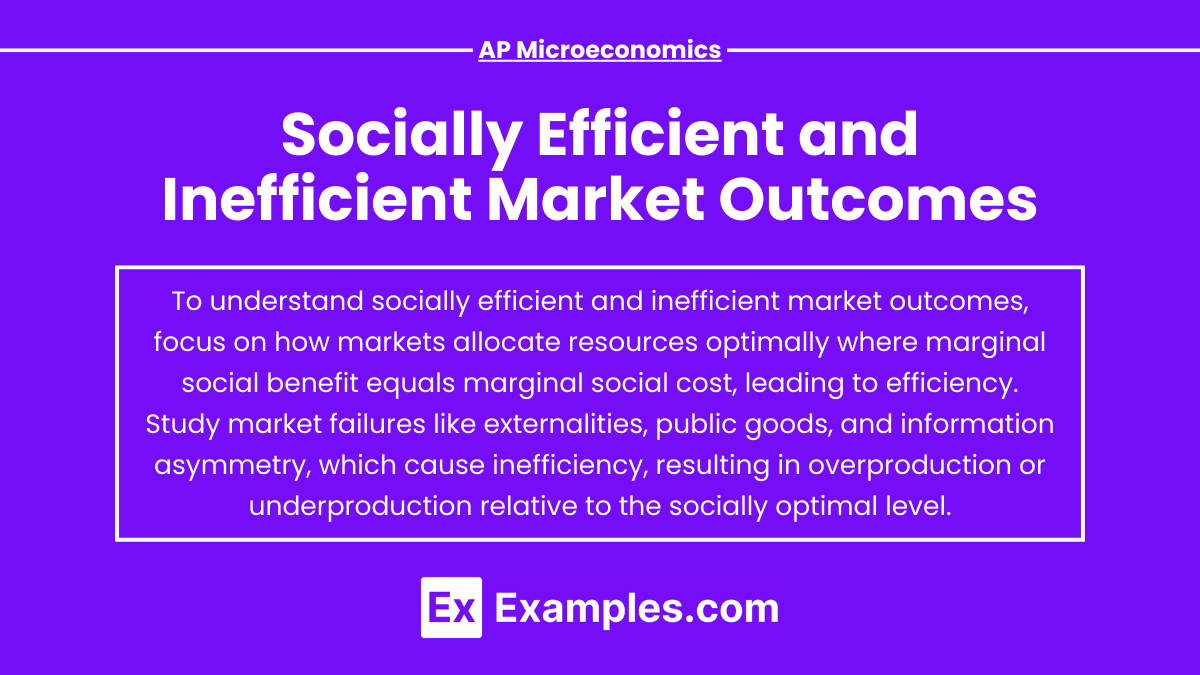In AP Microeconomics, socially efficient and inefficient market outcomes refer to how well resources are allocated to maximize societal welfare. A socially efficient outcome occurs when marginal benefit equals marginal cost, optimizing the production and consumption of goods. Conversely, inefficient outcomes arise due to market failures such as externalities, public goods, or monopolies, leading to either overproduction or underproduction. Understanding these concepts is critical to analyzing how markets function and when government intervention may be necessary to correct inefficiencies.
Learning Objectives
When studying “Socially Efficient and Inefficient Market Outcomes” for AP Microeconomics, you should learn to identify conditions for social efficiency, including how marginal benefit equals marginal cost (MB = MC). Understand the causes and consequences of socially inefficient outcomes, such as market failures, externalities, and deadweight loss. You should also learn how government interventions like taxes, subsidies, and regulations can correct inefficiencies, ensuring better resource allocation. Additionally, recognize the role of market structures in affecting social efficiency, including monopolies and competitive markets.
Socially Efficient Market Outcomes
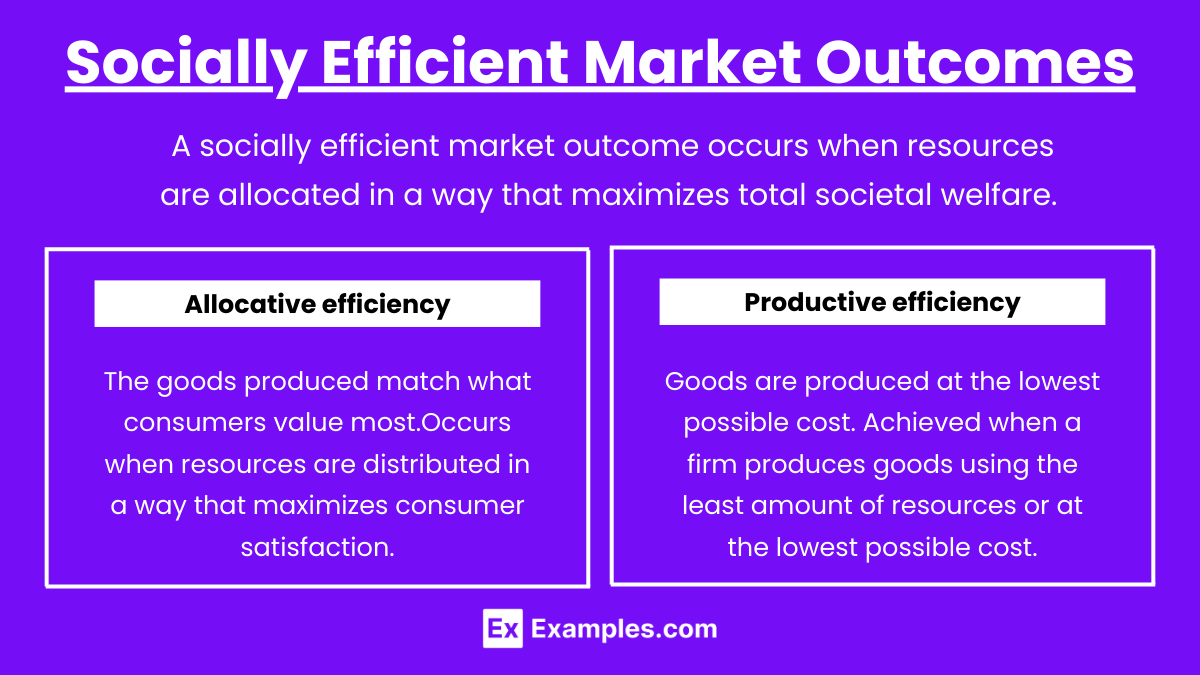
A socially efficient market outcome occurs when resources are allocated in a way that maximizes total societal welfare. This is achieved when the marginal benefit (MB) of consumption equals the marginal cost (MC) of production, leading to optimal resource allocation. In such markets, both consumer surplus and producer surplus are maximized, and no resources are wasted.
In perfectly competitive markets, this occurs at the equilibrium price and quantity, where demand intersects supply. At this point, the following conditions are met:
- Allocative efficiency: The goods produced match what consumers value most.Occurs when resources are distributed in a way that maximizes consumer satisfaction. The price of goods reflects consumer preferences, and production is aligned with societal demands.
- Productive efficiency: Goods are produced at the lowest possible cost. Achieved when a firm produces goods using the least amount of resources or at the lowest possible cost.
The concept of Pareto efficiency is often used to describe socially efficient outcomes—any change from this point would make at least one person worse off without making anyone better off.
Characteristics of Social Efficiency
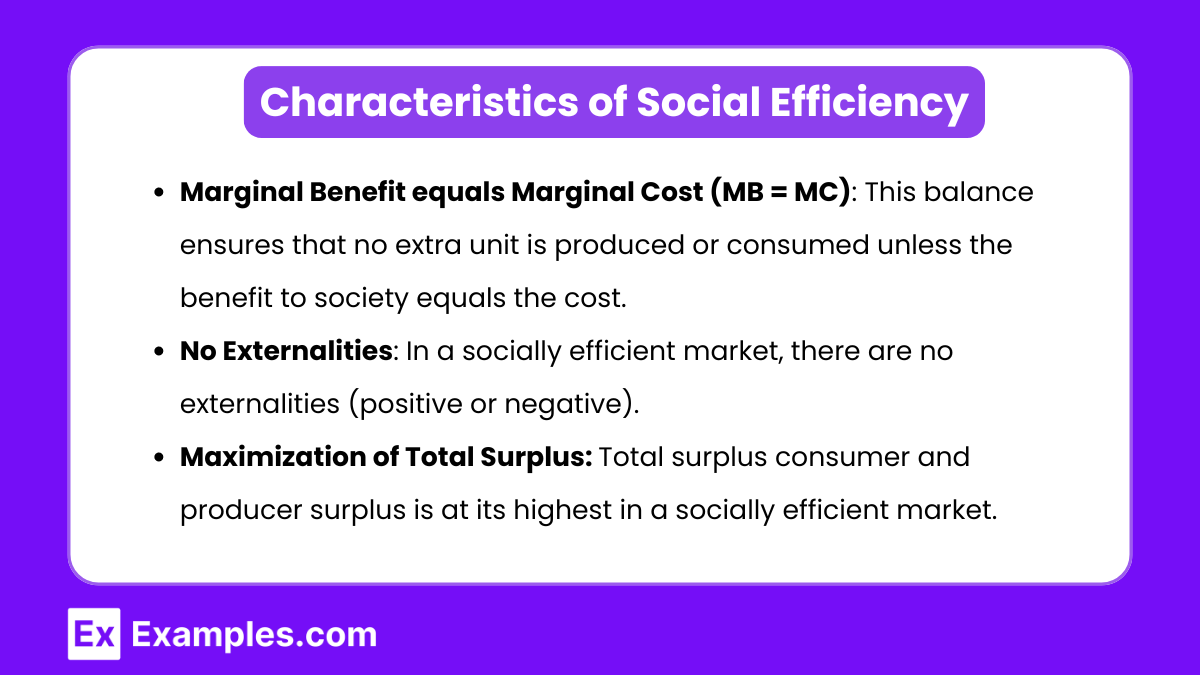
- Marginal Benefit equals Marginal Cost (MB = MC): This balance ensures that no extra unit is produced or consumed unless the benefit to society equals the cost.
- No Externalities: In a socially efficient market, there are no externalities (positive or negative). An externality is a cost or benefit that affects a third party who is not involved in the transaction.
- Maximization of Total Surplus: Total surplus (consumer and producer surplus) is at its highest in a socially efficient market.
Socially Inefficient Market Outcomes
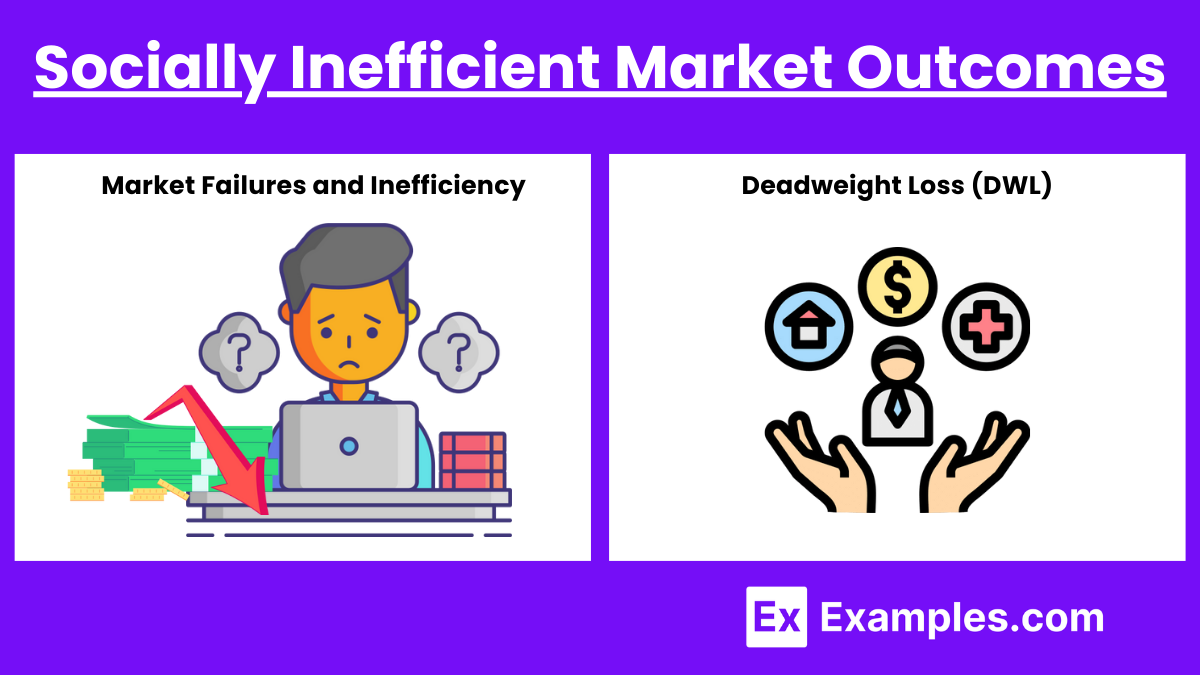
Socially Inefficient Market Outcomes Social inefficiency occurs when the market fails to allocate resources optimally, leading to either overproduction or underproduction of goods. Inefficiency can result from various factors, such as externalities, market power (monopolies), or information asymmetry.
- Market Failures and Inefficiency: When a market experiences failure, it typically results in an inefficient outcome, meaning that the equilibrium quantity of goods does not lead to maximized social welfare.
- Negative externalities (e.g., pollution): When the private cost of production is lower than the social cost, the good is overproduced, causing a deadweight loss (DWL). The market fails to account for the external harm imposed on society.
- Positive externalities (e.g., education): When the private benefit is lower than the social benefit, the good is underproduced, leading to a loss in potential welfare gains.
- Public goods (non-excludable and non-rivalrous goods): These are often underprovided by the free market because individuals can benefit from them without paying (free-rider problem), resulting in social inefficiency.
- Deadweight Loss (DWL): Social inefficiency is usually accompanied by a deadweight loss. DWL represents the lost welfare that neither consumers nor producers receive due to market distortion. In cases of monopolies, price is set above the socially efficient level, reducing consumer surplus and causing underproduction. This creates a welfare loss in the form of DWL.
Government Intervention for Inefficiencies
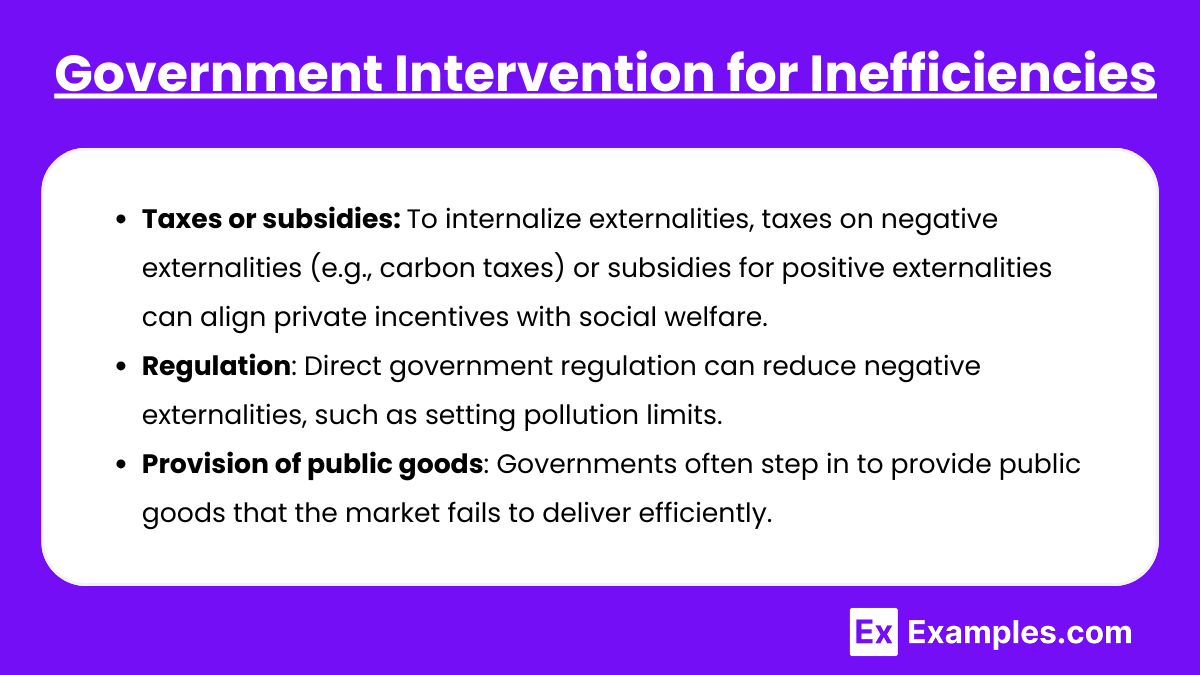
Government Intervention to Correct Inefficiencies Governments can intervene to correct inefficient outcomes through:
- Taxes or subsidies: To internalize externalities, taxes on negative externalities (e.g., carbon taxes) or subsidies for positive externalities (e.g., education grants) can align private incentives with social welfare.
- Regulation: Direct government regulation can reduce negative externalities, such as setting pollution limits.
- Provision of public goods: Governments often step in to provide public goods that the market fails to deliver efficiently.
Examples
Example 1. Social Efficiency in Perfect Competition
In a perfectly competitive market for agricultural products (e.g., wheat), firms produce goods at the lowest possible cost, and the price reflects both the marginal cost of production and the marginal benefit to consumers. Here, MB equals MC, and there are no externalities. Since prices are determined by market forces and there is a large number of buyers and sellers, the allocation of resources is socially efficient, and total surplus (consumer and producer surplus) is maximized. No deadweight loss occurs, and the market achieves both allocative and productive efficiency.
Example 2. Social Inefficiency Due to Negative Externalities
A common example of social inefficiency occurs in industries that generate pollution, such as the production of steel. Steel production creates negative externalities in the form of air pollution, which affects the health of individuals and the environment. In this case, the social cost of production (including the external costs of pollution) is higher than the private cost borne by the producers. As a result, the market overproduces steel, leading to social inefficiency. The market fails to account for the external harm, causing a deadweight loss as the marginal social cost exceeds the marginal benefit to society.
Example 3. Social Efficiency in the Provision of Healthcare
A government-subsidized healthcare system can be an example of social efficiency when it provides universal healthcare coverage at an affordable price. The market for healthcare often generates positive externalities, as healthier populations contribute to increased productivity and overall societal well-being. When the government steps in to provide or subsidize healthcare, it ensures that the market provides the socially optimal quantity of healthcare services. The positive externalities, such as a healthier workforce and reduced disease transmission, are fully accounted for, leading to a socially efficient outcome.
Example 4. Social Inefficiency in Monopolies
A monopoly in the pharmaceutical industry, where a single firm controls the production of life-saving drugs, can lead to social inefficiency. The monopolist sets a price higher than the marginal cost of production, resulting in underproduction of the drug relative to what would be socially efficient. Consumers who would benefit from purchasing the drug at a lower price are priced out of the market, leading to a deadweight loss. The monopolist captures higher profits, but total societal welfare is reduced because fewer people receive the life-saving drugs than would occur in a more competitive market.
Example 5. Social Inefficiency Due to Positive Externalities in Education
Education is another area where social inefficiency can arise when the market is left to private provision. Since education generates positive externalities—such as higher productivity, increased civic engagement, and reduced crime rates—the private benefit of education is less than the social benefit. When individuals make decisions based only on private costs and benefits, the result is underconsumption of education, leading to a socially inefficient outcome. Without government intervention through subsidies or public education systems, society experiences a loss in potential welfare, as fewer people obtain the education needed to generate these broad societal benefits.
Multiple Choice Questions
Question 1
Which of the following is true of a socially efficient market outcome?
A) The marginal benefit is greater than the marginal cost.
B) The marginal cost is greater than the marginal benefit.
C) The marginal benefit equals the marginal cost.
D) The market price is higher than the marginal cost.
Answer: C) The marginal benefit equals the marginal cost.
Explanation: A socially efficient market outcome occurs when the marginal benefit (MB) of consuming an additional unit of a good equals the marginal cost (MC) of producing it. This balance ensures that the resources are allocated optimally, and no additional goods are produced or consumed unless the benefit to society equals the cost. When MB equals MC, total societal welfare is maximized, which reflects allocative efficiency. If MB is greater than or less than MC, the market is either underproducing or overproducing, leading to social inefficiency.
Question 2
Which of the following market scenarios represents a socially inefficient outcome due to a negative externality?
A) A perfectly competitive market for bread, where demand equals supply.
B) A steel factory that pollutes a river without paying for the environmental damage.
C) A government-subsidized education system that provides education at no cost to citizens.
D) A monopoly pharmaceutical company charging a high price for life-saving drugs.
Answer: B) A steel factory that pollutes a river without paying for the environmental damage.
Explanation: A negative externality occurs when a third party, not directly involved in the transaction, bears the costs of production or consumption. In the case of the steel factory, the production causes pollution, which affects others (the public and the environment) without compensation. This results in a market failure, as the social cost (including environmental damage) is higher than the private cost paid by the factory. The market overproduces steel because it doesn’t account for the negative externality, leading to a socially inefficient outcome. This causes deadweight loss because the social cost exceeds the social benefit.
Question 3
Which of the following government interventions could help correct a socially inefficient outcome caused by a positive externality?
A) Imposing a tax on the good.
B) Introducing a price ceiling on the good.
C) Providing subsidies to consumers or producers of the good.
D) Setting a quota to limit the quantity produced of the good.
Answer: C) Providing subsidies to consumers or producers of the good.
Explanation: A positive externality occurs when the private benefit of consuming a good is lower than the social benefit, leading to underconsumption of the good. Education is a common example of this. The socially optimal outcome can be achieved when the government provides subsidies to either consumers or producers to encourage more consumption or production of the good. This shifts the supply or demand curve and helps the market reach the socially efficient quantity, maximizing societal welfare. A tax or quota would reduce production or consumption, worsening the inefficiency, and a price ceiling might cause shortages.

